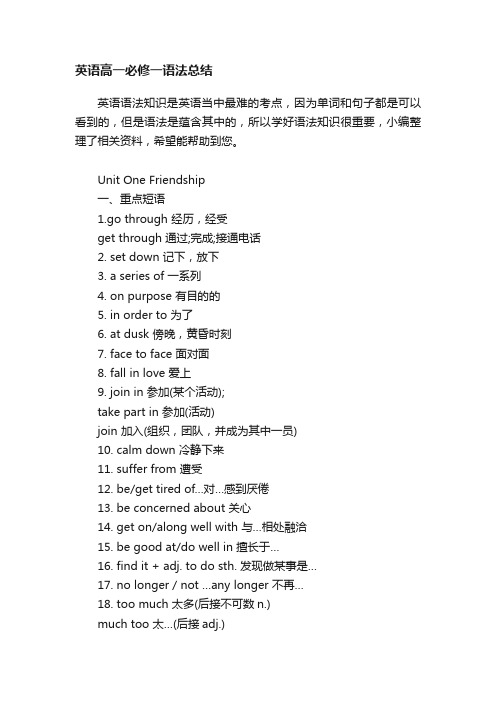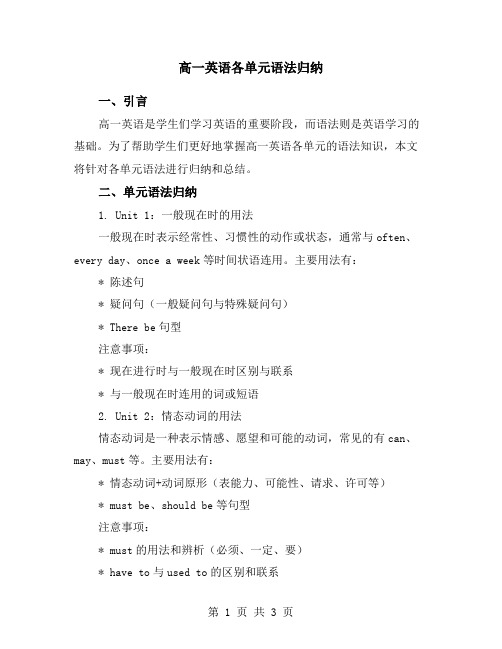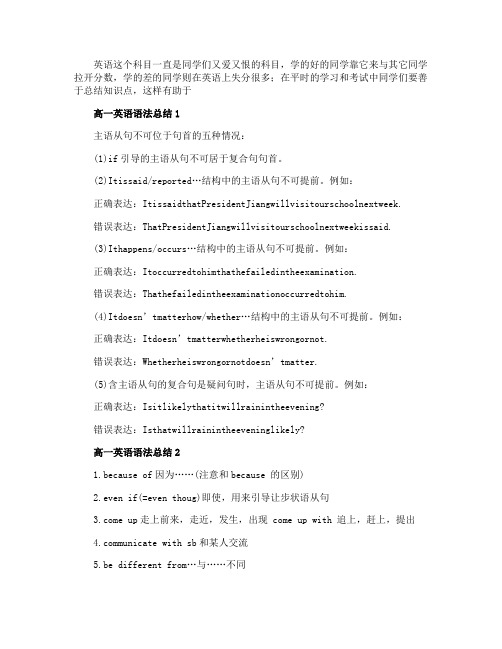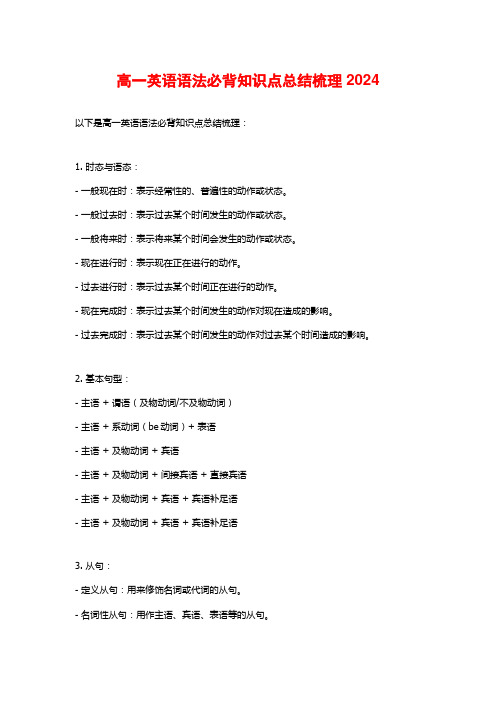高一英语语法归纳总结
英语高一必修一语法总结

英语高一必修一语法总结英语语法知识是英语当中最难的考点,因为单词和句子都是可以看到的,但是语法是蕴含其中的,所以学好语法知识很重要,小编整理了相关资料,希望能帮助到您。
Unit One Friendship一、重点短语1.go through 经历,经受get through 通过;完成;接通电话2. set down 记下,放下3. a series of 一系列4. on purpose 有目的的5. in order to 为了6. at dusk 傍晚,黄昏时刻7. face to face 面对面8. fall in love 爱上9. join in 参加(某个活动);take part in 参加(活动)join 加入(组织,团队,并成为其中一员)10. calm down 冷静下来11. suffer from 遭受12. be/get tired of…对…感到厌倦13. be concerned about 关心14. get on/along well with 与…相处融洽15. be good at/do well in 擅长于…16. find it + adj. to do sth. 发现做某事是…17. no longer / not …any longer 不再…18. too much 太多(后接不可数n.)much too 太…(后接adj.)19. not…until 直到… 才20. it’s no pleasure doing sth 做… 并不开心21. make sb. sth. 使某人成为…make sb. do sth. 使某人做某事二、语法----直接引语和间接引语概念:直接引语:直接引述别人的原话。
一般前后要加引号。
间接引语:用自己的话转述别人的话。
间接引语在多数情况下可构成宾语从句且不要加引号。
例:Mr. Black said, “ I’m busy.”Mr. Black said that he was busy.变化规则(一)陈述句的变化规则直接引语如果是陈述句,变为间接引语时,用连词that(可省略)引导,从句中的人称、时态、指示代词、时间状语、地点状语都要发生相应的变化。
高一英语重点语法知识点总结归纳5篇分享

高一英语重点语法知识点总结归纳5篇分享高一英语语法1一般现在时1. 表示现在习惯或经常反复发生的动作或存在的状态, 常与usually, always, sometimes, often, every day /week / month / year等时间状语连用.[例句] He often does his homework in his study.2. 表示主语现在的特征.性格和状态.[例句] The dictionary belongs to me.3. 表示客观规律或科学真理.格言, 以及其他不受时间限制的客观存在.[例句] The moon goes around the sun.4. 在有连词if, unless, before, as soon as, when, once,however等引导的时间.条件和让步状语从句中, 用一般现在时表将来.[例句] If you work hard, you won’t fail in the e_am.高一英语语法2(一) 语法一致原则: 即主语为单数,谓语用单数,主语为复数,谓语也用复数.以下为注意事项: 1. 单数主语即使后面带有with , alongwith, together with, like(象), but (除了),e_cept, besides, as well as, no lessthan, rather than(而不是), including, in addition to 引导的短语, 谓语动词仍用单数.如: Air as wellas water is matter. 空气和水都是物质.No one e_cept two servants was late for the dinner.除了两个仆人外, 没有一个人迟来用餐. 2. 用and连接的并列主语,如果主语是同一个人,同一事,同一概念, 谓语动词用单数, 否则用复数.如: Thepoet and writer has come. 那位诗人兼作家来了.(一个人) A hammer and a saw are useful tools.锤子和锯都是有用的工具. (两样物) 用and连接的成对名词习惯上被看成是一个整体, 如:bread and butter(黄油抹面包), knife andfork(刀叉)等作主语时, 谓语动词用单数. 3. 不定式(短语), 动名词(短语),或从句作主语时, 谓语动词用单数. 如: Serving thepeople is my great happiness. 为人民服务是我的幸福. When we’ll go out for an outing hasbeen decided. 我们什么时候出去郊游已决定了. 4. 用连接的并列主语被each, every 或no修饰时, 谓语动词用单数. Every boyand every girl likes to go swimming. 每个男孩和每个女孩都喜欢去游泳. No teacher and no studentwas absent from the meeting. 没有老师也没有学生开会缺席. Each man and (each) woman is askedto help. 每个男人和每个女人都被请去帮忙. 5. each of + 复数代词, 谓语动词用单数. 复数代词+each, 谓语动词用单数.如: Eachof us has something to say. 我们每个人都有话要说. 6. 若主语中有more than one 或many a/an ,尽管从意义上看是复数, 但它的谓语动词仍用单数. 但more+复数名词+than one 做主语时, 谓语动词仍用复数. 如: Many a boy likesplaying basketball. 许多男生都喜欢打篮球. More than one student was late. 不只一个学生迟到 Morepersons than one come to help us. 不止一个人来帮助我们. 7. none 做主语时,谓语动词可用单数, 也可用复数;但在代表不可数的东西时总是看作单数,因而谓语动词要用单数. 如: None of us are (is) perfect. 人无完人. None of thisworries me. 这事一点不使我着急. 8. 名词如: trousers, scissors, clothes, goods, glasses等作主语时, 谓语动词必须用复数. 如: His clothes are good. 但这些名词前若出现 a pair of , 谓语一般用单数.如: Apair of glasses is on the desk. 桌上有一副眼镜. 9. 形复意单名词如:news ; 以ics 结尾的学科名称如:physics, mathematics, economics; 国名如: the United States; 报纸名如: theNew Times;书名如: Arabian Night 天方夜谈以及The United Nations 联合国等作主语时, 谓语动词用单数.10. 〝a +名词+and a half 〝, 〝one and a half + 名词〞, 〝the number of + 名词〞等作主语时,谓语动词要用单数. 如: Only one and a half apples is left on the table. 注意: one or two +复数名词作主语, 谓语动词用复数形式, 如: One or two places have been visited. 参观了一两个地点.高一英语语法3一般将来时1. 表示将来发生的动作或存在的状态, 常与表示将来的时间状语连用.[例句] I don’t know what will happen in the future.2. 常用来表示将来时的结构包括:(1) shall / will + 动词原形:(单纯) 表将来, 一般不用于条件句.(2) be going to + 动词原形:(计划)打算做…….(3) be about to + 动词原形:即将或正要去做某事,通常不与时间状语连用,但可与when引导的从句连用.(4) be to + 动词原形:预定要做…….(5) be doing 表示按计划.安排即将发生的动作,常与go, start, set out, leave, reach, arrive,return, come, move等表位移的动词连用.高一英语语法4非真实条件句1)时态:可以表示过去,现在和将来的情况.它的基本特点是时态退后.a. 同现在事实相反的假设.句型 : 条件从句主句一般过去时 should( would) +动词原形If they were here, they would help you.b. 表示于过去事实相反的假设.句型: 条件从句主句过去完成时 should(would) have+ 过去分词If she had worked harder, she would have succeeded.The rice would not havebeen burnt if you had been more careful.If my lawyer had been here last Saturday, he would have prevented me fromgoing.If he had come yesterday, I should / would have told him about it.含义:He did not come yesterday, so I did not tell him about it.If he had not been ill and missed many classes, he would have made greaterprogress. 含义: He was ill and missed many lessons, so he did not make greaterprogress.c. 表示对将来的假想句型: 条件从句主句一般过去时 should+ 动词原形were+ 不定式 would + 动词原形should+ 动词原形If you succeeded, everything would be all right.If you should succeed, everything would be all right.If you were to succeed, everything would be all right.高一英语语法5一. 直接引语和间接引语(一)直接引述别人的原话,叫做直接引语;用自己话转述别人的话,叫做间接引语.间接引语一般构成宾语从句.直接引语必须放在引号内,间接引语则不用引号.直接引语改为间接引语时,除将引语部分变成宾语从句外,还必须对直接引语中的人称.时态.指示代词.时间状语.地点状语等进行改变.1. 时态的变化:直接引语变为间接引语时,通常受转述动词said,asked等的影响而使用过去化的时态,即把原来的时态向过去推,也就是一般现在时变为一般过去时,现在进行时变为过去进行时,等等.例如:Tom said to me,〝My brother is doing his homework.〞→Tom said to me that his brother was doing his homework.2. 人称代词.指示代词.时间状语.地点状语等等的变化: 根据意义进行相应的变化,例如:She asked Jack,〝Where have you been?〞→She asked Jack where he had be en.He said,〝These books are mine.〞→He said t hat those books were his.(二)直接引语改为间接引语时,都使用陈述语序,但是因为原句的句式不同,所以变成间接引语时所用的连词会有所不同.直接引语如果是一般疑问句,用连接词whether或if;如果是特殊疑问句,则用疑问词引导间接引语.转述的动词一般用asked,可以在其后加上一个间接宾语me,him, her, us等.如:She said,〝Is your father at home?〞→She asked me i f/whether my father was at home.〝What do you do every Sunday?〞My friend asked me.→My friend asked me what I did every Sunday.直接引语如果是祈使句,改为间接引语时,要将祈使句的动词原形变为带to的不定式,并在不定式的前面根据原句的语气(即请求或命令)加上ask, tell,order等动词,如果祈使句为否定式,则在不定式前加not.其句型为:ask / tell / order someone (not) to dosomething. 例如:She said to us,〝Please sit down.〞→She asked us to sit down.He said to him,〝Go away!〞→He ordered him to go away.He said, 〝Don’t make so much noise, boys.〞→He told the boys not to make so much noise.最新高一英语重点语法知识点总结归纳5篇分享。
高一英语各单元语法归纳

高一英语各单元语法归纳一、引言高一英语是学生们学习英语的重要阶段,而语法则是英语学习的基础。
为了帮助学生们更好地掌握高一英语各单元的语法知识,本文将针对各单元语法进行归纳和总结。
二、单元语法归纳1. Unit 1:一般现在时的用法一般现在时表示经常性、习惯性的动作或状态,通常与often、every day、once a week等时间状语连用。
主要用法有:* 陈述句* 疑问句(一般疑问句与特殊疑问句)* There be句型注意事项:* 现在进行时与一般现在时区别与联系* 与一般现在时连用的词或短语2. Unit 2:情态动词的用法情态动词是一种表示情感、愿望和可能的动词,常见的有can、may、must等。
主要用法有:* 情态动词+动词原形(表能力、可能性、请求、许可等)* must be、should be等句型注意事项:* must的用法和辨析(必须、一定、要)* have to与used to的区别和联系3. Unit 3:被动语态的用法被动语态表示主语是动作的承受者,常用的有be done、get done等形式。
主要用法有:* 被动语态的结构(be done)和形式(be being done)* 与被动语态连用的动词类型(及物动词)* 主动语态变被动语态的步骤和注意事项4. Unit 4:定语从句的用法定语从句是在句子中起修饰或限制作用的关系词,常用的关系词有that、which、who等。
主要用法有:* 关系词的种类和用法(that、which、who等)* 关系词的省略和替代(关系代词省略和关系副词替代)* 定语从句与同位语从句的区别和联系注意事项:* 限制性和非限制性定语从句的区别和联系* 关系代词that与which的区别和适用范围5. Unit 5:虚拟语气用法虚拟语气用于表达某种非真实条件状语从句,常见的有wish、if only等。
主要用法有:* 虚拟语气的形式和用法(建议、要求、建议未实现等)* 与虚拟语气连用的从句类型(名词性从句、定语从句)和从句引导词类型。
高一英语语法知识点归纳总结

高一英语语法知识点归纳总结高一英语语法知识点总结高一英语语法知识点总结(一)1. 定义:用作表语的从句叫做表语从句。
2. 构成:关联词+简单句3. 引导表语从句的关联词的种类:(1) 从属连词that。
例如:The trouble is that I have lost his address. 麻烦是我把他的地址丢了。
(2) 从属连词whether, as, as if。
例如:He looked just as he had looked ten years before. 他看起来还与十年前一样。
The question is whether they will be able to help us. 问题是他们是否能帮我们。
注:从属连词if一般不用来引导表语从句,但as if却可引导表语从句,例如:All this was over twenty years ago, but its as if it was only yesterday. 这都是20多年前的事了,但宛如昨天一样。
能跟表语从句的谓语动词一般为系动词be, seem, look等。
例如: It looked as if it was going to rain. 看起来天要下雨了。
(3)连接代词:Who whom whose whatWhich whoever whatever whichever连接副词:Where when how why例如:The problem is who we can get to replace her. 问题是我们能找到谁去替换她呢。
The question is how he did it. 问题是他是如何做此事的。
That was what she did this morning on reaching the attic. 那就是她今晨上了阁楼干的。
注:1. 连词because可引导表语从句。
高一英语语法知识点归纳五篇

高一英语语法知识点归纳五篇英语的时态语法学习很重要哦,时态语法的正确运用能加分不少。
下面就是给大家带来的高一英语语法总结,希望能帮助到大家!高一英语语法总结1各种时态的被动语态被动语态概述被动语态的概念:它是动词的一种形式,表示主语与谓语之间的执行或被执行关系。
主动语态表示主语是谓语动作的执行者,例如:They saw the little boy crying by the river. 被动语态表示主语是谓语动作的承受者,例如:The little boy was seen crying by the river.被动语态的构成被动语态的形式是由“助动词be+动词的过去分词”构成。
助动词be随着主语的人称、数、时态等的不同而变化。
几种常见时态的被动语态形式如下:1. 一般现在时am/is/are + 过去分词例如:Rice is planted in the south of China.2. 一般过去时was/were + 过去分词例如:These trees were planted the year before last.3. 一般将来时will/shall + be + 过去分词例如:A sports meeting will be held next week in our school.4. 现在进行时am/is/are + being + 过去分词例如:Your radio is being repaired now.5. 过去进行时was/were + being + 过去分词When he got there, the problem was being discussed.6. 现在完成时have/has + been + 过去分词His work has been finished.Has his work been finished? Yes, it has. / No, it hasn’t.7. 过去完成时had + been + 过去分词注意:1.除了be之外的其它系动词如get, stay等也可以和过去分词构成被动语态。
高一英语语法知识点总结

高一英语语法知识点总结知识点高一英语语法高一英语知识点归纳高中语法知识点总结高一英语的语法知识点篇一:高中英语语法知识点总结高中语法知识点总结第一章冠词高考对冠词的考查集中在基本用法上,主要既反映在对泛指、特指及固定短语冠词的考查。
抽象名词、物质名词的具体化依然是高考的重点、难点。
一、不定冠词不定冠词a,an与one同源,表示微弱的―一‖的概念,但并不强调数目,用来表示不确定的人或事物。
A用在辅音前,而不是辅音字母前;an用在元音前,而不是元音字母前。
a university in Asia1.表示同类中的―任何一个‖A cat has nine lives.2.表示泛指的某人、某物I know a John Lennon,but not the famous one.3.表示数量的―一‖He has a daughter.4. 表示单位数量的‖每一‖I earn 10 dollars an hour.5.表示相同的‖The two birds are of a color.6. 用于集体名词前He grows up in a large family.7. 在某种情况下可用于抽象名词和物质名词前China has a long history.二、定冠词的用法1.表示特定的人或物2.表示地球、宇宙中独一无二的事物主要指各种天体及世界上比较有影响的物体。
The sun,the moon,the earth3.表示地点、方向、时间、方式等at the corner 在拐角处1)在表示季节的名词前常不用冠词。
In spring 在春天2) 具体某年的某个季节,需用冠词。
In the summer of the year20083)用于序数词或形容词的最高级前the first the second4)用于形容词前使其名词化the rich the poor5)用于复数姓氏前,表示―夫妇‖或全家The Smiths6)用于乐器名词前Play the piano7)用于by+the+计量单位名词By the pound1. 用于复数名词前复数名词泛指某类人或物时,其前通常用零冠词。
高一英语语法归纳总结5篇

英语这个科目一直是同学们又爱又恨的科目,学的好的同学靠它来与其它同学拉开分数,学的差的同学则在英语上失分很多;在平时的学习和考试中同学们要善于总结知识点,这样有助于高一英语语法总结1主语从句不可位于句首的五种情况:(1)if引导的主语从句不可居于复合句句首。
(2)Itissaid/reported…结构中的主语从句不可提前。
例如:正确表达:ItissaidthatPresidentJiangwillvisitourschoolnextweek.错误表达:ThatPresidentJiangwillvisitourschoolnextweekissaid.(3)Ithappens/occurs…结构中的主语从句不可提前。
例如:正确表达:Itoccurredtohimthathefailedintheexamination.错误表达:Thathefailedintheexaminationoccurredtohim.(4)Itdoesn’tmatterhow/whether…结构中的主语从句不可提前。
例如:正确表达:Itdoesn’tmatterwhetherheiswrongornot.错误表达:Whetherheiswrongornotdoesn’tmatter.(5)含主语从句的复合句是疑问句时,主语从句不可提前。
例如:正确表达:Isitlikelythatitwillrainintheevening?错误表达:Isthatwillrainintheeveninglikely?高一英语语法总结21.because of因为……(注意和because 的区别)2.even if(=even thoug)即使,用来引导让步状语从句e up走上前来,走近,发生,出现 come up with 追上,赶上,提出municate with sb和某人交流5.be different from…与……不同be different in…在……方面不同Most of my projects are different in performance.我多数作品的演奏风格都不同。
高一英语语法必背知识点总结梳理2024

高一英语语法必背知识点总结梳理2024 以下是高一英语语法必背知识点总结梳理:1. 时态与语态:- 一般现在时:表示经常性的、普遍性的动作或状态。
- 一般过去时:表示过去某个时间发生的动作或状态。
- 一般将来时:表示将来某个时间会发生的动作或状态。
- 现在进行时:表示现在正在进行的动作。
- 过去进行时:表示过去某个时间正在进行的动作。
- 现在完成时:表示过去某个时间发生的动作对现在造成的影响。
- 过去完成时:表示过去某个时间发生的动作对过去某个时间造成的影响。
2. 基本句型:- 主语 + 谓语(及物动词/不及物动词)- 主语 + 系动词(be动词)+ 表语- 主语 + 及物动词 + 宾语- 主语 + 及物动词 + 间接宾语 + 直接宾语- 主语 + 及物动词 + 宾语 + 宾语补足语- 主语 + 及物动词 + 宾语 + 宾语补足语3. 从句:- 定义从句:用来修饰名词或代词的从句。
- 名词性从句:用作主语、宾语、表语等的从句。
- 状语从句:用来修饰动词、形容词、副词等的从句。
4. 形容词与副词的比较级和最高级:- 一般形容词比较级:原级 + er。
- 一般形容词最高级:原级 + est。
- 一般副词比较级:原级 + er。
- 一般副词最高级:原级 + est。
5. 句子成分:- 主语- 谓语- 宾语- 表语- 定语- 状语6. 虚拟语气:- 虚拟条件句:表示与事实相反或与实际情况不符的假设。
- 虚拟语气的使用:表示愿望、建议、命令等。
- 与过去事实相反的虚拟:表达过去不可能实现的愿望或假设。
7. 时态与语态的转换:- 时态转换:根据具体语境和表达需要,将动词的时态进行转换。
- 语态转换:将主动语态转换为被动语态或将被动语态转换为主动语态。
8. 动词的非谓语形式:- 不定式:一般用作动词的基本形式,表示动作或状态的概念。
- 动名词:以-ing结尾,用作名词。
- 分词:以-ing或-ed结尾,用作形容词或副词。
- 1、下载文档前请自行甄别文档内容的完整性,平台不提供额外的编辑、内容补充、找答案等附加服务。
- 2、"仅部分预览"的文档,不可在线预览部分如存在完整性等问题,可反馈申请退款(可完整预览的文档不适用该条件!)。
- 3、如文档侵犯您的权益,请联系客服反馈,我们会尽快为您处理(人工客服工作时间:9:00-18:30)。
高一英语语法归纳总结----定语从句的归纳一.几个基本概念1.定语从句的定义:用作定语的从句叫定语从句。
2.先行词:被定语从句所修饰的名词或代词。
3.定语从句的位置:紧跟先行词(名词或代词)之后。
4.引导词:引导定语从句的词(包括关系代词和关系副词)。
﹙1﹚关系代词:that/who/whom/which/as﹙2﹚关系副词:when/where/why5.引导词的位置:位于定语从句之前(先行词之后)。
【as 除外】 6.引导词的功能(作用):﹙1﹚连接先行词和定语从句。
﹙2﹚在定语从句中充当一定的成分(关系代词充当主语或宾语,关系副词充当状语)。
7.定语从句的类型:﹙1﹚限定性定语从句(主句和定语从句之间无逗号)。
① 直接由引导词引导定语从句The man who you’re talking to is my friend.② 由介词+关系代词(whom/which)引导The man to whom you’re talking is my friend.I need a pen with which I can write a letter.=I need a piece of paper on which I can write a letter.介词的选用可根据从句中的相关词组确定,该介词通常可以放在关系代词之前,也可放在从句之尾。
例如:The man (who/whom/that) I talked about at the meeting is from Beijing University.=The man about whom I talked at the meeting is from Beijing University.The palace (which/that) I often pay a visit to was built in the 17th century.=The palace to which I often pay a visit was built in the 17th century.﹙2﹚非限定性定语从句(主句和定语从句之间用逗号隔开)。
① 直接由引导词引导定语从句。
② 由介词+关系代词(whom/which)引导。
I live in a house far away from the city, in front of which is a big tree.There is an apple tree standing at the gate, on which are many apples.This is the man to whom I gave the book.③ 由“代词/名词+of+whom/which”或“of which/ whom +名词/代词”(先行词指人用whom,指物用which)引导。
One, some, any, none, all, both, several, many, most, neither, either 等词、数词、分数或百分比与 of whom 或 of which 连用。
He has five children, two of whom are abroad. (比较:Hehas five children, and two of them are abroad.)We have three books, none of which is/are interesting. (比较:We have three books, but none of them is/are interesting.)除why和that不能引导非限定性定语从句外,其余引导词都可以,用法同限定性定语从句一样。
但要注意以下区别。
1.在形式上非限定性定语从句与主句有逗号隔开。
2.非限定性定语从句的作用:它只是补充说明先行词的情况,翻译时可译成两个句子。
The engineer, whose leg was badly hurt, was quickly sent to hospital.(那位工程师被很快送往医院,其腿部受了重伤)The engineer whose leg was badly hurt was quickly sent to hospital.(那位腿部受了重伤的工程师被很快送往医院)3.在非限定性定语从句中,任何引导词都不能省略(包括引导词在此定语从句中充当宾语在内)。
指人做主语时只能用who,做宾语时用whom;指物做主语,宾语都用which;关系副词用when或where,也不能省略。
The man, ______ is sitting on the chair, is my father.The woman, _______ I met yesterday, is my English teacher.The city, _______ is far away, is very beautiful.He went to America, ______ his parents live. Hejoined the Army yesterday, ______ I left, too.4.whose 引导非限定性定语从句:The house, whose window faces south, is mine.=The house, the window of which faces south, is mine.=The house, of which the window faces south, is mine.二.定语从句中关系代词和关系副词的基本用法。
1.who/that 指人是主格在定语从句中代替先行词,又作定语从句的主语,不能省略。
Do you know the gentleman who/that is sitting there?2.whom/who/that 指人是宾格,在定语从句中代替先行词,又作定语从句的宾语(动宾或介宾)。
① 当作动宾(动词后接宾语)时,关系代词可省略。
Do you know the gentleman (whom/who/that) we met just now?② 当作介宾(介词后接宾语)时:介词不提前时,关系代词可省略;介词提前时,关系代词不可省,即介词+whom(指人时介词后的关系代词只能用whom)。
The man (whom/who/that) I spoke with is my teacher.The man with whom I spoke is my teacher.※注:固定的动词短语(动词+介词)如look for, take care of等不能把动词与介词拆开,既介词不能提至引导词前。
She is the right girl (who/whom/that) we are looking for.3.whose: 指人或物,是所有格“…的”形式。
Whose+n.一起在定语从句中充当主语、宾语(动宾或介宾)即先行词的什么东西怎样了,whose不能省略。
Whose+n. = the +n. + of which/whom= of which/ whom+ the =n.I didn’t find the desk whose leg was broken. (主语)He is the student whose pencil I broke yesterday. (动宾)The boss in whose company I work is very kind. (介宾)4.which/that 指物,指代先行词且在定语从句中作主语或宾语(动宾或介宾)。
① 当作动宾时,关系代词可省略。
② 当作介宾时:介词不提前时,关系代词可省略;介词提前时,关系代词不可省,即介词+which(指物时介词后的关系代词只能用which)。
The house which/that was destroyed in the earthquake is weak.The pen (which/that) you found yesterday is mine.The games (that/which) the young men competed in were difficult.The games in which the young men competed were difficult.※注:介词+关系代词即介词+whom/which(先行词指人用whom,指物用which)。
※5.as指人或物,在定语从句中可作主语,宾语,表语或状语,不能省略。
主要用于“the same …as…;such …as…;so …as…;as … as…;as follows”固定结构中,形式固定此时的引导限定性定语从句。
要用as代替who(m), which,或that引导定语从句:Such people as knew Hill thought he was honest.Such people as Hill knew thought he was honest.My hometown is no longer the same as it was.Here is so big a stone as no one can lift.The child knows as much as grow-ups (know).I’d like to have the same books as are used in your school.He is not such a person as I expected.He will marry as pretty a girl as he can find.※注:which和as可引导非限定性定语从句:可以指代主句中的一部分或整个句子的内容,which 和 as 都可以指代主句中的一部分或整个句子的内容,有时可以互换。
因此,当as/which指代前面的整个句子,或前句中的部分内容作定语从句的主语时,谓语用单数.Our team lost the game, as/which was reported in the newspaper.She was terrified, as/which I could see from her eyes.He married her, as/which was natural.区别:①as引导的非限制性定语从句可以放在主句前面、插在主句中间或放在主句末尾;而which引导的非限制性定语从句只能放在主句后面。
